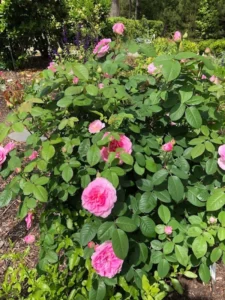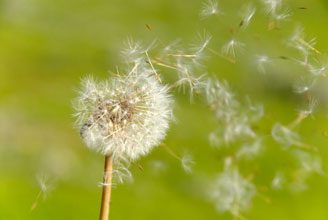
Gertrude Jekyll Rosebush
My favorite rose bush just died. It shriveled up and all of the leaves fell off with no new shoots coming out from the base. What did I do, besides mourn? I blamed myself. Was it a disease? I do not use sprays or any kind of pesticides. Was it neglect? I water regularly and feed when it is necessary according to a schedule I received from the rose grower. Why did this happen? What did I do wrong? It was one of my oldest roses and I lost another one last year that was the first rose I bought.
I read and researched and finally emailed the rose grower in England for advice. They immediately wrote back and quoted the leading rosarian and one of my heroes, Michael Marriott. He wrote: “Austin roses, like any variety, will have no fixed life. It depends very much on the variety, the way they are looked after and the conditions they are growing in.” I had my answer. This rose bush had basically bloomed itself to death. With our conditions in the Lowcountry, my roses bloom nearly all year long. Most plants need a period of rest or dormancy. Lesson learned. It was not my fault.
It is easy and so common to blame ourselves when we lose a plant. It is important to keep in mind that all plants have a life expectancy. Even Live Oaks, the oldest of which has been living for 1,600 years will eventually succumb to old age. Plants that are referred to as “perennial” really do not have that long a life expectancy – 10 to 15 years is considered a long-lived perennial. Of course, it may seem like certain plants last longer than that because they reseed and reproduce giving a continuum of blooms. There are currently studies being done on the longevity of plants and how climate change is affecting this.
One of my favorite perennials is the Coneflower (Echinacea purpurea). Coneflowers are American native prairie plants and they thrive with cold winters and hot dry summers. With progressively warming winters, their longevity is being challenged. Studies in Europe are showing that they live the longest in northern and eastern Europe in places like Poland and Russia. In my own garden, they are abundant, but I am certain that is because they are reseeding as I scatter the seed heads around when I deadhead. Gardeners worldwide are enamored with American prairie plants because of their toughness and the fact that they tend to bloom later in the season. Climate change may affect this.
What other conditions might cause you as a gardener to lose a plant? Aside from life expectancy, over watering is one of the biggest causes of root rot and plant loss. It is true that during hot weather plants need more water than usual, but many people feel that they need to water every day and run their irrigation regardless of rainfall. Container plants may need water every day, but it is doubtful that plants in good soil that are properly mulched will require that much water.
Incorrect initial planting is a huge factor in plant viability. Many landscapers and homeowners plant shrubs and garden plants too low. They should have the root flare at the top of the soil. The last thing that you should have is a deep bowl around the base to collect water. Roots need to breathe keep them at the surface.
And of course, there are plant disease and pests that can cause a plant to succumb. Good air flow, proper pruning, judicious watering, and fertile soil will help keep pests and disease at bay. I cannot emphasize enough the importance of good air flow in the garden to prevent disease. If I see something that looks like a disease or a pest, I remove the infected leaves and discard them. That is far better than using a pesticide that may or may not work and can cause harm to our environment.
If you do lose a plant, learn to let go. Think of this as an opportunity to try a new plant in that spot. If you believe that the plant has died due to disease, remove the soil where the plant or shrub was and replace it with fresh compost. When our weather is cooler, I plan on replacing my rose with one like it. I will dig out the old roots and soil and replace it. The old story that you cannot plant a rose in the same place is a myth, but I always like to use new compost when planting anything. Most importantly, I will not blame myself, but recognize that, like life, change in the garden is inevitable.









